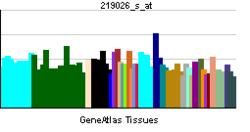RASAL2
| RAS protein activator like 2 | |||||||||||||
|---|---|---|---|---|---|---|---|---|---|---|---|---|---|
| Identifiers | |||||||||||||
| Symbols | RASAL2 ; NGAP | ||||||||||||
| External IDs | OMIM: 606136 HomoloGene: 35217 GeneCards: RASAL2 Gene | ||||||||||||
| |||||||||||||
| RNA expression pattern | |||||||||||||
 | |||||||||||||
| More reference expression data | |||||||||||||
| Orthologs | |||||||||||||
| Species | Human | Mouse | |||||||||||
| Entrez | 9462 | 226525 | |||||||||||
| Ensembl | ENSG00000075391 | ENSMUSG00000070565 | |||||||||||
| UniProt | Q9UJF2 | D3YUS5 | |||||||||||
| RefSeq (mRNA) | NM_004841 | NM_177644 | |||||||||||
| RefSeq (protein) | NP_004832 | NP_808312 | |||||||||||
| Location (UCSC) | Chr 1: 178.06 – 178.45 Mb | Chr 1: 157.14 – 157.41 Mb | |||||||||||
| PubMed search | |||||||||||||
Ras GTPase-activating protein nGAP is an enzyme that in humans is encoded by the RASAL2 gene.[1][2]
This gene encodes a protein that contains the GAP-related domain (GRD), a characteristic domain of GTPase-activating proteins (GAPs). GAPs function as activators of Ras superfamily of small GTPases. The protein encoded by this gene is able to complement the defective RasGAP function in a yeast system. Two alternatively spliced transcript variants of this gene encoding distinct isoforms have been reported.[2]
References
- ↑ Noto S, Maeda T, Hattori S, Inazawa J, Imamura M, Asaka M, Hatakeyama M (Jan 1999). "A novel human RasGAP-like gene that maps within the prostate cancer susceptibility locus at chromosome 1q25". FEBS Lett 441 (1): 127–31. doi:10.1016/S0014-5793(98)01530-0. PMID 9877179.
- ↑ 2.0 2.1 "Entrez Gene: RASAL2 RAS protein activator like 2".
Further reading
- Maekawa M, Nakamura S, Hattori S (1993). "Purification of a novel ras GTPase-activating protein from rat brain.". J. Biol. Chem. 268 (30): 22948–52. PMID 8226805.
- Bonaldo MF, Lennon G, Soares MB (1997). "Normalization and subtraction: two approaches to facilitate gene discovery.". Genome Res. 6 (9): 791–806. doi:10.1101/gr.6.9.791. PMID 8889548.
- Seki N, Ohira M, Nagase T et al. (1998). "Characterization of cDNA clones in size-fractionated cDNA libraries from human brain.". DNA Res. 4 (5): 345–9. doi:10.1093/dnares/4.5.345. PMID 9455484.
- Strausberg RL, Feingold EA, Grouse LH et al. (2003). "Generation and initial analysis of more than 15,000 full-length human and mouse cDNA sequences.". Proc. Natl. Acad. Sci. U.S.A. 99 (26): 16899–903. doi:10.1073/pnas.242603899. PMC 139241. PMID 12477932.
- Ota T, Suzuki Y, Nishikawa T et al. (2004). "Complete sequencing and characterization of 21,243 full-length human cDNAs.". Nat. Genet. 36 (1): 40–5. doi:10.1038/ng1285. PMID 14702039.
- Bouwmeester T, Bauch A, Ruffner H et al. (2004). "A physical and functional map of the human TNF-alpha/NF-kappa B signal transduction pathway.". Nat. Cell Biol. 6 (2): 97–105. doi:10.1038/ncb1086. PMID 14743216.
- Jin J, Smith FD, Stark C et al. (2004). "Proteomic, functional, and domain-based analysis of in vivo 14-3-3 binding proteins involved in cytoskeletal regulation and cellular organization.". Curr. Biol. 14 (16): 1436–50. doi:10.1016/j.cub.2004.07.051. PMID 15324660.
- Gregory SG, Barlow KF, McLay KE et al. (2006). "The DNA sequence and biological annotation of human chromosome 1.". Nature 441 (7091): 315–21. doi:10.1038/nature04727. PMID 16710414.
- Olsen JV, Blagoev B, Gnad F et al. (2006). "Global, in vivo, and site-specific phosphorylation dynamics in signaling networks.". Cell 127 (3): 635–48. doi:10.1016/j.cell.2006.09.026. PMID 17081983.